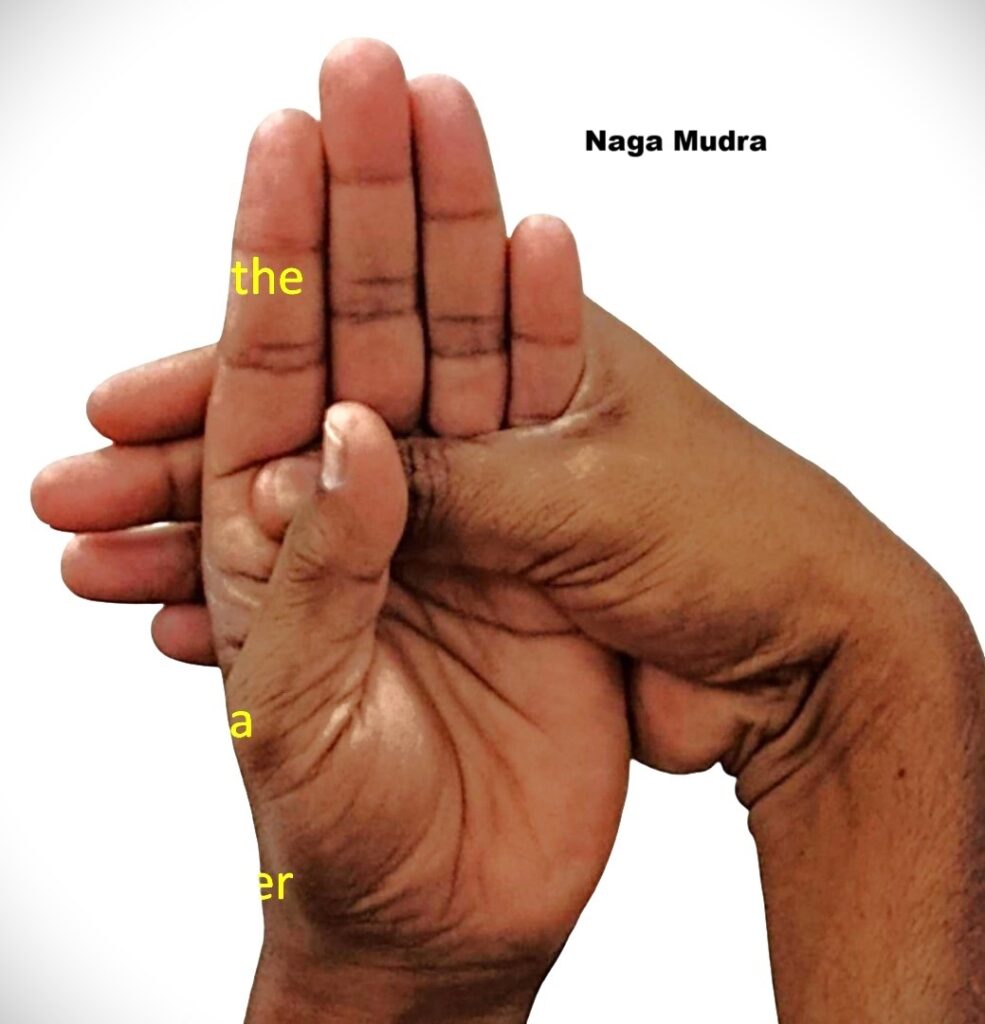Naga Mudra
Introduction
Naga Mudra is an important hasta mudra (hand gesture) in yoga and meditation. The Sanskrit word Naga means “serpent” or “cobra,” symbolizing hidden wisdom, inner strength, and transformation. Just as a snake sheds its skin, this mudra represents the removal of ignorance and awakening of higher consciousness. It is often practiced for clarity in decision-making, intuition, and spiritual growth.
It is commonly used during meditation when facing confusion, doubts, or indecisiveness, as it helps channel intuition and inner wisdom.
Meaning
Naga = Serpent / Cobra (symbol of wisdom, energy, and rebirth)
Mudra = Gesture or seal
Thus, Naga Mudra = Serpent Gesture, symbolizing the unlocking of hidden knowledge and intuitive power.
How to Perform Practice
Sit in a meditative posture (Padmasana, Sukhasana, or Vajrasana). Keep the spine straight.
Cross the hand in front of chest and also cross the thumbs keeping the palms one upon the other and place this mudra on the lap.
The thumb placed on the palm increases all elements like vayu, akasha, prithvi and jala
The thumb placed upon the other thumb increases the agni, blazing fire is a powerful element.
Close the eyes and breathe deeply.
Focus on a specific question, confusion, or inner guidance.
Meditate in this position for 5–15 minutes.
Benefits
Physical Benefits
Helps reduce stress and anxiety by calming the nervous system.
Balances breathing, improving lung capacity.
Regulates heart rate and blood circulation.
Enhances digestion by reducing psychosomatic tension.
Mental & Emotional Benefits
Brings clarity during confusion or indecision.
Awakens inner wisdom and intuition.
Helps release suppressed emotions.
Encourages self-confidence and inner peace.
Spiritual Benefits
Symbolizes the serpent energy (kundalini shakti) rising upward.
Opens the heart chakra (Anahata) and strengthens inner connection.
Enhances meditation by deepening awareness.
Used for guidance in spiritual practices, like asking life questions to the higher self.
Contraindications
Avoid when feeling overheated, restless, or excessively stimulated, as it can increase inner energy.
People with severe hypertension should practice for short durations.
Not advised if experiencing dizziness or migraine during practice.
Should be avoided immediately after heavy meals.
Anatomy & Physiology
Engages the palmar muscles and interossei of the hand.
Activates the respiratory system by aligning breath with focus.
Stimulates the parasympathetic nervous system, reducing stress.
Improves posture by bringing awareness to the chest and heart area.
Kinesiology
Involves isometric contraction of hand and finger muscles.
Engages pectoral muscles as palms press together.
Supports spinal alignment by encouraging upright sitting.
Gentle pressure in the thumbs stabilizes hand coordination.
Neurology
Activates the prefrontal cortex, enhancing decision-making and clarity.
Stimulates vagus nerve activity, calming the heart and digestion.
Supports neuroplasticity by linking symbolic hand movements with mental states.
Enhances right-left brain hemisphere balance through hand crossing.
Duration of Mudra
General practice: 5–15 minutes once or twice daily.
For decision-making: Practice until a sense of clarity arises (usually 5–10 minutes).
For meditation: Up to 30 minutes with intervals.
Counter Mudra
Jnana Mudra → for mental clarity and wisdom.
Hakini Mudra → for concentration and memory.
Anjali Mudra → for grounding and devotion.
Conclusion
Naga Mudra is a powerful serpent gesture that symbolizes wisdom, transformation, and clarity. It is especially beneficial for those who struggle with confusion, doubts, or emotional turmoil. On a physical level, it helps calm the nervous system and improve heart and lung functions. On a spiritual level, it enhances intuition and awakens the inner serpent energy (kundalini shakti). Practiced regularly, it becomes a tool for inner guidance, emotional balance, and spiritual awakening.
FAQ
Q1: Can Naga Mudra help me make decisions?
Yes, it is specifically recommended for clarity during confusion or life decisions.
Q2: When is the best time to practice Naga Mudra?
Early morning or before meditation, especially when seeking inner guidance.
Q3: Can beginners practice it?
Yes, it is safe and simple for all levels of practitioners.
Q4: Does it activate kundalini energy?
Symbolically, yes—it represents the serpent energy rising, though it primarily works on clarity and intuition.
Q5: Can it be practiced during stress?
Yes, it is excellent for calming stress and restoring focus.
References
Swami Satyananda Saraswati – Asana, Pranayama, Mudra, Bandha
Gertrud Hirschi – Mudras: Yoga in Your Hands
Indu Arora – Mudra: The Sacred Secret
Bihar School of Yoga – Publications on Hasta Mudras
Dr. Dhirendra Brahmachari – Mudra Vigyan
